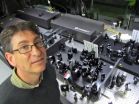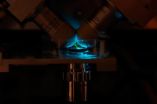Drug development in the blink of an eye
2011-08-09
The development of drugs for brain-related conditions is not an efficient process; only 8% of candidate drugs that enter clinical trials gain FDA approval. A key reason for this low success rate is a lack of preclinical tests that accurately predict drug efficacy and detect unwanted side effects. But now, Jeremy Nathans and colleagues, at Johns Hopkins University School of Medicine, Baltimore, have developed a new preclinical approach that they hope can be used alongside current strategies to guide more efficient drug development for brain-related conditions.
In the study, ...
JCI online early table of contents: August 8, 2011
2011-08-09
EDITOR'S PICK: Drug development in the blink of an eye
The development of drugs for brain-related conditions is not an efficient process; only 8% of candidate drugs that enter clinical trials gain FDA approval. A key reason for this low success rate is a lack of preclinical tests that accurately predict drug efficacy and detect unwanted side effects. But now, Jeremy Nathans and colleagues, at Johns Hopkins University School of Medicine, Baltimore, have developed a new preclinical approach that they hope can be used alongside current strategies to guide more efficient ...
When and how to toilet train children
2011-08-09
Parents often ask their doctors for advice on toilet training young children, and a new article in CMAJ (Canadian Medical Association Journal) (pre-embargo link only) http://www.cmaj.ca/site/embargo/cmaj110830.pdf summarizes current approaches and evidence to help physicians respond to these queries.
"Toilet training is felt to be a natural process that occurs with development, yet very little scientific information is available for physicians who care for children," writes Dr. Darcie Kiddoo, Divisions of Pediatric Surgery and Urology, University of Alberta, Edmonton, ...
Gladstone scientist discovers genetic factor implicated in heartbeat defect
2011-08-09
SAN FRANCISCO, CA—August 8, 2011—A scientist at the Gladstone Institutes has discovered how gene regulation can make hearts beat out of sync, offering new hope for the millions who suffer from a potentially fatal heart condition.
In a paper being published this week in the online Early Edition of the Proceedings of the National Academy of Sciences, Gladstone Investigator Benoit G. Bruneau, PhD announces the identity of the molecular regulator that uses electrical impulses to synchronize each heartbeat.
Abnormalities in heartbeat synchronization, called heart arrhythmias, ...
Study urges caution with lenalidomide dosage
2011-08-09
COLUMBUS, Ohio – An early phase multiple myeloma trial has unexpectedly revealed that the drug lenalidomide interacts with another protein in cells that affect its dose level in the body, say researchers at the Ohio State University Comprehensive Cancer Center – Arthur G. James Cancer Hospital and Richard J. Solove Research Institute (OSUCCC – James) who conducted the study.
Lenalidomide is an anti-inflammatory drug, and more than 390 clinical trials have been initiated to study its activity in a number of cancers and other diseases.
The study found that lenalidomide ...
Buyer beware -- herbal products missing key safety information
2011-08-09
Many people use herbal medicines believing them to be safe simply because they are 'natural'. However many of these products have potentially dangerous interactions with other drugs and can have similar side effects to conventional drugs. New research published in BioMed Central's open access journal BMC Medicine reveals that many over-the-counter herbal products do not contain any of the key information required for safe use.
Despite their wholesome image, many herbal products have adverse effects and a third of users are completely unaware of any risks. Researchers ...
Herbal remedies escape EU law
2011-08-09
Many herbal remedies available over-the-counter in pharmacies and health food shops are still lacking important information needed for safe use, according to University of Leeds researchers.
In April this year, a new EU law came into force regulating the sale of traditional herbal medicines, such as St John's wort and Echinacea. These products must now contain clear information on possible side effects, how they could interact with other prescribed medicines and whether people with existing illnesses should take them or not. They are clearly marked with the THR logo showing ...
Chimpanzees are spontaneously generous after all
2011-08-09
Researchers at the Yerkes National Primate Research Center have shown chimpanzees have a significant bias for prosocial behavior. This, the study authors report, is in contrast to previous studies that positioned chimpanzees as reluctant altruists and led to the widely held belief that human altruism evolved in the last six million years only after humans split from apes. The current study findings are available in the online edition of Proceedings of the National Academy of Sciences.
According to Yerkes researchers Victoria Horner, PhD, Frans de Waal, PhD, and their ...
Connecting the dots: Pitt School of Dental Medicine team describes how enamel forms
2011-08-09
PITTSBURGH, Aug. 8 – Researchers at the University of Pittsburgh School of Dental Medicine are piecing together the process of tooth enamel biomineralization, which could lead to novel nanoscale approaches to developing biomaterials. The findings are reported online this week in the Proceedings of the National Academy of Sciences.
Dental enamel is the most mineralized tissue in the body and combines high hardness with resilience, said Elia Beniash, Ph.D., associate professor of oral biology, Pitt School of Dental Medicine. Those properties are the result of its unique ...
Deep brain stimulation effects may last for 10 years in patients with Parkinson's disease
2011-08-09
One decade after receiving implants that stimulate areas of their brains, patients with Parkinson's disease (PD) appear to sustain improvement in motor function, although part of the initial benefit wore off mainly because of progressive loss of benefit in other functions, according to a report published Online First by Archives of Neurology, one of the JAMA/Archives journals.
According to background information in the article, several previous clinical studies have shown deep brain stimulation of the subthalamic nucleus (STN-DBS) for PD to be effective and safe. Studies ...
Women more likely to recruit other women for political office
2011-08-09
Los Angeles, CA (DATE) The gender composition of those responsible for candidate recruitment plays a crucial role in either encouraging or discouraging women candidates to run for office, according to a recent study in Political Research Quarterly (PRQ) published by SAGE on behalf of the Western Political Science Association.
"Researchers Christine Cheng and Margit Tavits looked at "party gatekeepers" (local party presidents) from the five major political parties in the 2004 and 2006 Canadian national elections. Unlike the US, the nomination of party candidates for the ...
Age and severity of heart failure associated with impairment in verbal memory
2011-08-09
Older patients with lower rates of left ventricular ejection fraction (a measure of how well the left ventricle of the heart pumps with each contraction) appear more likely than younger patients to have significantly reduced verbal memory function, according to a report in the August issue of Archives of Neurology, one of the JAMA/Archives journals.
Three decades ago, researchers began investigating the association of heart failure with cognitive decline, according to background information in the article. Thirty to 80 percent of patients with heart failure may experience ...
Blood loss from lab testing associated with hospital-acquired anemia for patients with heart attacks
2011-08-09
In patients with acute myocardial infarction (heart attack), blood loss from greater use of phlebotomy (blood drawn for diagnostic testing) appears to be independently associated with the development of hospital-acquired anemia (HAA), according to a report published Online First by Archives of Internal Medicine, one of the JAMA/Archives journals. The article is part of the journal's Less Is More series.
Anemia (low red blood cell count or low hemoglobin level) is associated with greater mortality and worse health status in patients with AMI, whether the condition is chronic ...
Researchers develop risk assessment model for advanced age-related macular degeneration
2011-08-09
A new risk assessment model may help predict development of advanced age-related macular degeneration, according to a report published Online First by Archives of Ophthalmology, one of the JAMA/Archives journals.
Age-related macular degeneration (AMD) is a leading cause of blindness in the United States and the Western world, according to background information in the article. "As progress in designing better preventive measures and earlier treatment options accelerates and new gene associations are identified that add to currently known risk factors, the desirability ...
More frequent visual field testing may lead to earlier detection of glaucoma progression
2011-08-09
In patients with glaucoma, frequent visual field testing may be associated with earlier detection of the condition's progression, according to a report published Online First by Archives of Ophthalmology, one of the JAMA/Archives journals.
According to background information in the article, visual field testing is one of the main ways of monitoring patients with glaucoma for progression. "Estimating rates of progression can help identify patients who are progressing at a faster pace and are therefore at serious risk of developing visual disability during their lifetime," ...
Soy tablets not associated with reduction in bone loss or menopausal symptoms in women
2011-08-09
Soy isoflavone tablets do not appear to be associated with a reduction in bone loss or menopausal symptoms in women within the first five years of menopause, according to a report in the August 8 issue of Archives of Internal Medicine, one of the JAMA/Archives journals.
The beginning stages of menopause are often accompanied by rapid bone loss, hot flashes, vaginal dryness and sleep disturbances among other symptoms, according to background information in the article. "Estrogen therapy with or without progesterone prevents most of these changes. However, as a result of ...
Massachusetts health-care reform associated with increased demand for medical safety-net facilities
2011-08-09
Patient demand for care from safety-net providers (such as community health centers and public hospitals) in Massachusetts has increased, even though the number of patients with health insurance also increased following the state's passage of health care reform, according to a report in the August 8 issue of Archives of Internal Medicine, one of the JAMA/Archives journals. The article is part of the journal's Health Care Reform series.
According to background information in the article, a disproportionate share of patients who do not have health insurance obtain care ...
Newly discovered antibody recognizes many strains of flu virus
2011-08-09
Some vaccines are once-in-a-lifetime; others need a booster shot or two to maintain their potency. And then there's the flu vaccine, which only lasts a year. Strains of influenza virus change so much from year-to-year that new vaccines must be developed annually to target the strains of virus that are most likely to cause illness. But Howard Hughes Medical Institute (HHMI) scientists have now discovered a human antibody that recognizes many different flu strains. Understanding more about this antibody may help scientists design a longer-lasting vaccine against the influenza ...
Meteorites: Tool kits for creating life on Earth
2011-08-09
Washington, D.C.—Meteorites hold a record of the chemicals that existed in the early Solar System and that may have been a crucial source of the organic compounds that gave rise to life on Earth. Since the 1960s, scientists have been trying to find proof that nucleobases, the building blocks of our genetic material, came to Earth on meteorites. New research, published next week in the Proceedings of the National Academy of Sciences, indicates that certain nucleobases do reach the Earth from extraterrestrial sources, by way of certain meteorites, and in greater diversity ...
Biology, materials science get a boost from robust imaging tool
2011-08-09
EUGENE, Ore. -- (Aug. 8, 2011) -- Shape and alignment are everything. How nanometer-sized pieces fit together into a whole structure determines how well a living cell or an artificially fabricated device performs. A new method to help understand and predict such structure has arrived with the successful use a new imaging tool.
Coupling laser-driven, two-dimensional fluorescence imaging and high-performance computer modeling, a six-member team -- led by University of Oregon chemist Andrew H. Marcus and Harvard University chemist Alan Aspuru-Guzik -- solved the conformation ...
Guam researcher studies Mount Pinatubo ecosystem recovery
2011-08-09
University of Guam ecologist Thomas Marler recently mobilized efforts to characterize the vegetation that has recovered following the eruption of Mount Pinatubo, Philippines. "My interest was sparked by the paradox that this volcano's cataclysmic 1991 eruption was so powerful it changed global climate, yet after a full 15 years the biology of the recovering ecosystem had not been studied," said Marler.
The void of research motivated the Guam ecologist to spend a majority of 2006 conducting botanical surveys on the mountain. Marler then teamed up with University of Washington ...
Heavy metal -- in and around the lakes
2011-08-09
Heavy metal pollution of lakes has a seriously detrimental impact on people and ecosystems that rely on such bodies of water. According to a study published in the current issue of Interdisciplinary Environmental Review, researchers have focused on the physicochemical properties and toxicology of water from and around Thane City of Maharashtra.
Environmental chemist Pravin Singare of Bhavan's College, in Mumbai, and colleagues highlight the fact that fresh water bodies all over the world are becoming increasingly polluted day by day and that this represents a growing ...
Improved radical surgery techniques provide positive outcomes for bladder cancer patients
2011-08-09
Bladder cancer patients who have radical surgery at university hospitals can benefit from excellent local control of the disease, acceptable clinical outcomes and low death rates, according to research in the August issue of the urology journal BJUI.
Researchers studied 2,287 patients who had radical cystectomy surgery, where the bladder is removed, together with nearby tissue and organs as required. The surgery was performed at eight Canadian academic centres between 1998 and 2008.
The study found that there were three independent factors, apart from pathological ...
Live from the scene: Biochemistry in action
2011-08-09
Researchers can now watch molecules move in living cells, literally millisecond by millisecond, thanks to a new microscope developed by scientists at the European Molecular Biology Laboratory (EMBL) in Heidelberg, Germany. Published online today in Nature Biotechnology, the new technique provides insights into processes that were so far invisible.
By combining light-sheet microscopy and single molecule spectroscopy, the new microscope can record the fluorescence of every pixel within view, and take snapshots at intervals of less than one millisecond. With it, scientists ...
'Paranoia' about rivals alters insect mating behavior
2011-08-09
Scientists at the University of Liverpool have found that male fruitflies experience a type of 'paranoia' in the presence of another male, which doubles the length of time they mate with a female, despite the female of the species only ever mating with one male.
Females in many species of animal have multiple mates and males have evolved particular reproductive characteristics to ensure their sperm are successful when in competition with the sperm of other males. Adaptations include physical traits that result in increased sperm count, as well as behavioural alterations ...
[1] ... [6921]
[6922]
[6923]
[6924]
[6925]
[6926]
[6927]
[6928]
6929
[6930]
[6931]
[6932]
[6933]
[6934]
[6935]
[6936]
[6937]
... [8713]
Press-News.org - Free Press Release Distribution service.


